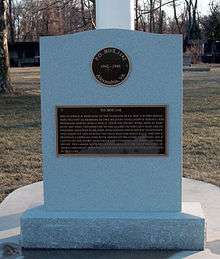P. O. Box 1142
P.O. Box 1142 was a secret American military intelligence facility that operated during World War II.[1] The American Military Intelligence Service had two special wings, known as MIS-X and MIS-Y.

The MIS-X program focused upon the escape and evasion activities of American POWs in Europe.
MIS-Y's core duty was to interview the Prisoners of War (POWs). They were known by their codename, the mailing address "P.O. Box 1142."[2] Notable prisoners housed at the facility included rocket scientist Wernher von Braun, spymaster Reinhard Gehlen, and Heinz Schlicke, inventor of infrared detection.[3] German U-Boat commander Werner Henke was also a prisoner but was fatally shot when he tried to escape by climbing the fence.[4] [5]
P.O. Box 1142 was based in Fort Hunt, Virginia,[1] formerly part of George Washington's farmlands. German scientists, submariners and soldiers were questioned.[2] P.O. Box 1142 obtained valuable intelligence from German POWs and also communicated with Allied POWs overseas. The camp was in violation of the Geneva Convention (P.O. Box 1142 was closed in 1946; the Geneva Convention was not ratified until 1949) because the Red Cross was not notified of the transfer or location of the prisoners, but according to the surviving wardens, torture was not used.[4] The work done at Fort Hunt contributed to the Allied victory of World War II. It also led to advances in scientific technology and military intelligence that directly influenced the Cold War.[1] In October 2007, a group of the former intelligence workers gathered for the first time since the war's conclusion,[4] and a flagpole and plaque recognizing their contributions were dedicated on the original grounds.[3][6]
The camp was started in 1942; the majority of the camp facilities were bulldozed in 1946.[3] The post commanders were: Col. Daniel W. Kent (1 July 1942–21 October 1942); Col. Russell H. Sweet (21 October 1942–1 February 1943); Col. John L. Walker (1 February 1943–18 July 1945); and Col. Zennas R. Bliss (18 July 1945–post closure).
Operation Paperclip
PO Box 1142 was one of a number of secret internment facilities commissioned by the United States with the goal to exploit the German scientists recruited as part of Operation Paperclip[7] in Europe. In order to prevent scientists specializing in rocket and other sensitive technologies from falling into Communist hands, the United States became determined to prevent the Soviet Union from seizing scientists with this information prior to the end of the war. The U.S. Joint Intelligence Objectives Agency[8] was responsible for sponsoring the operation and took a specific focus on the scientists who had worked on Hitler's V2 Rocket program.
Interrogation process
As many of the former prison guards and interrogators at PO Box 1142 have started to grow old and information become declassified, the substantial amount of information learned at PO Box 1142 has started to come to light. Between 1942 and 1946, the military interrogators at the camp questioned more than 3,400 prisoners with more than 500 of these being scientists that came to the United States as part of Operation Paperclip.[9] During these interviews, significant information regarding German advances in rocketry, jet technology, weapons systems, and acoustic torpedoes was discovered. The United States was able to take this information and develop an effective acoustic torpedo countermeasure.
The former interrogators say they did not use physical torture, however they did use psychological tricks, like threatening to turn the prisoner over to the Soviet NKVD. National Park Service Ranger Brandon Bies interviewed over 70 former interrogators from PO Box 1142 on this topic and said: "To our knowledge, no. There was no torture here. This is a question that was asked in every interview the National Park Service conducted, and we have found no evidence that there was anything remotely resembling torture that happened here."[10]
During the many interrogations, I never laid hands on anyone. We extracted information in a battle of the wits. I'm proud to say I never compromised my humanity.
— George Frenkel, US interrogator, Dvorak, Petula (October 6, 2007). "Fort Hunt's Quiet Men Break Silence on WWII". Washington Post. Retrieved 2017-02-26.
Later reception
In 2001, the German historian Sönke Neitzel found about 150,000 pages of interrogation reports and bugged room conversations made in Trent Park and Fort Hunt. He analysed them together with Harald Welzer, a social psychologist. They published several books about their results:
- Abgehört: Deutsche Generäle in britischer Kriegsgefangenschaft 1942-1945. Ullstein, Berlin 2005 (edited by Neitzel) [English: Tapping Hitler's Generals: Transcripts of Secret Conversations, 1942-1945. Frontline Books, 2007. ISBN 978-1844157051].
- »Der Führer war wieder viel zu human, viel zu gefühlvoll«: Der Zweite Weltkrieg aus der Sicht deutscher und italienischer Soldaten (2011) (edited by Neitzel, Welzer and Christian Gudehus).
- Soldaten. Protokolle vom Kämpfen, Töten und Sterben. S. Fischer, Frankfurt am Main 2011 (written by Neitzel and Welzer) [English: Soldaten: On Fighting, Killing and Dying. Simon & Schuster, 2012].
Another member of the research group, Felix Römer, wrote Kameraden. Die Wehrmacht von innen. Piper, Munich 2012.
See also
- Camp Tracy, similar camp for Japanese and German POWs
- MI9, the British equivalent of MIS-X
References
- World War II Vets Honored For Top-Secret Work, NPS Digest.
- Dvorak, Petula, 2006-08-20, World War II secret interrogators break their silence, Washington Post.
- Albrecht, Brian (2008-01-11). "Long hidden, a Nazi-interrogation unit gets its due". The Plain Dealer. Retrieved 2008-01-11.
- Dvorak, Petula (6 October 2007). "Fort Hunt's Quiet Men Break Silence on WWII". The Washington Post. Retrieved 2008-01-11.
- Mulligan, Timothy (1993). Lone Wolf: The Life and Death of U-Boat Ace Werner Henke (book). ISBN 0-275-93677-5.
- Fessler, Pam (2008-08-18). "Breaking The Silence Of A Secret POW Camp". Morning Edition. NPR. Retrieved 2008-08-18.
- Harney, Will. "Operation Paperclip". World War 2 Facts. Retrieved 20 November 2013.
- "Joint Intelligence Objectives Agency". U.S. National Archives and Records Administration. U.S. National Archives and Records Administration. Retrieved 20 November 2013.
- "PO Box 1142". Militarian.com. Retrieved 20 November 2013.
- http://www.cbsnews.com/news/secret-wwii-camp-interrogators-say-torture-wasnt-needed/